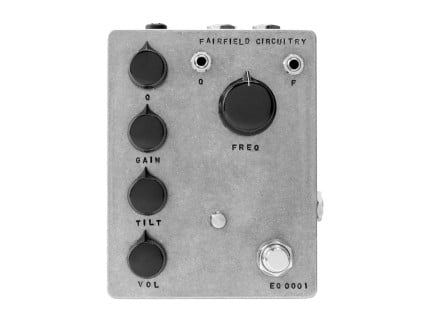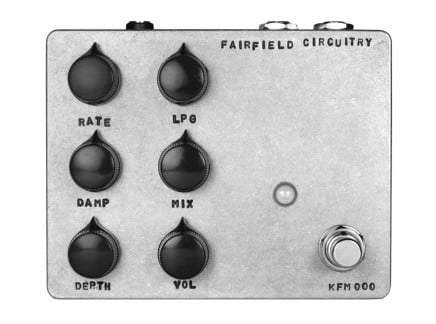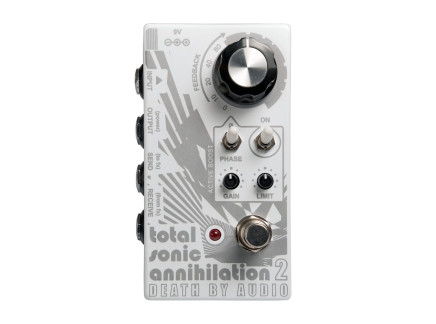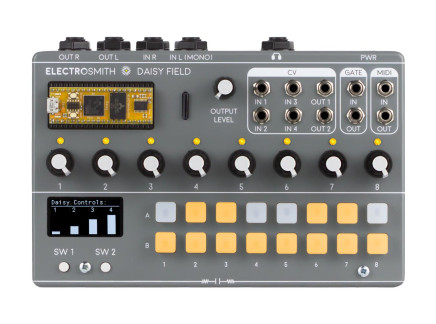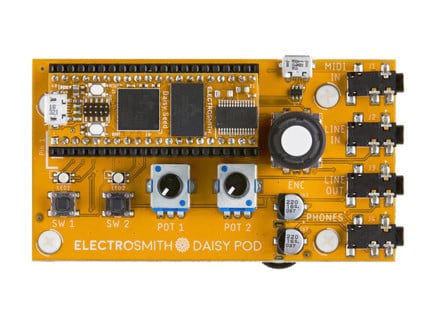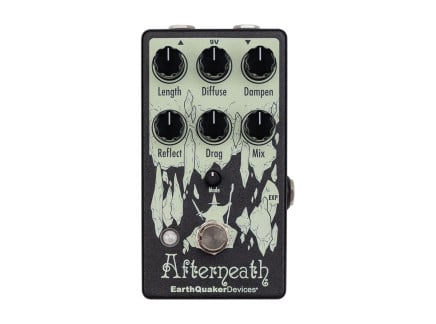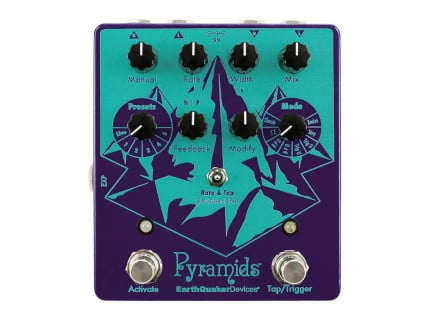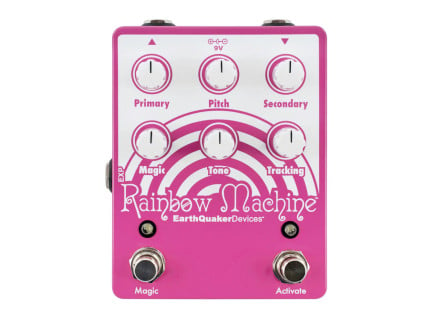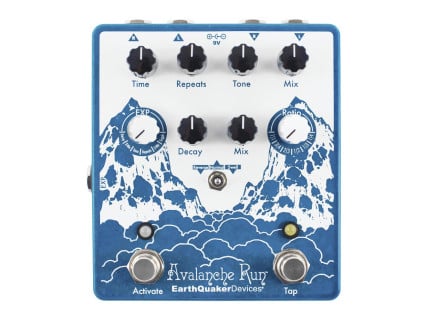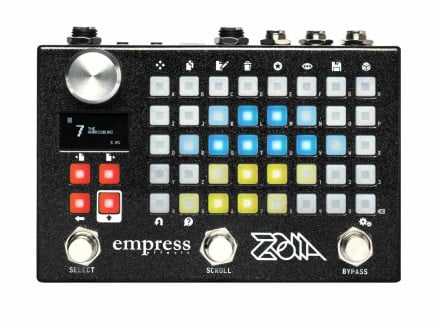Based on what we've seen from the Eurorack modules, standalone synthesizers, and drum machines/grooveboxes released in 2020, it comes as no surprise that we saw some incredible effect pedals debut this year. No longer tools designed with guitarists strictly in mind, it's more apparent than ever that many makers are also thinking about keyboardists, synthesists, producers, and other musically-inclined folk in their newest designs. With companies like Chase Bliss breaking new ground in pedal hardware design to others like Poly Effects and Electrosmith putting the power to design your own effects in the hands of the players, the pedal industry is more alive and innovative than ever before. So as 2021 knocks at our door, let's reflect on some of our favorite pedals from the past 12 months.
Creative Looping At Its Finest: Blooper
Haven't you always wanted a bottomless looper? I'm not just talking about the number of loops you get, but bottomless in the sense of boundless possibilities. Blooper from Chase Bliss Audio fills this niche, a flexible and open-ended looper pedal that captures the imagination. Blooper combines high-quality looping with creative and dynamic ways to alter these loops, using internal and external sources.
To begin, Blooper functions as a traditional looper. Plug an audio source into the input, output to a mixer or speaker, and press the record button to capture a snippet of audio. Once this audio is in the buffer, you can get creative with it. Add the feel of an old tape machine with wow and flutter using the stability control. Blooper also functions as a long-form delay, building up and fading away at a speed set by the repeats knob. If you make a mistake, use the layers knob to undo or redo the layers present in the buffer.
The two modifiers add a new level of loop manipulation that brings your sounds to life. Smoothly control both the speed and direction of your loops using the Smooth control. Dropper destructively drops out portions of your loop, either a consistent drop pattern or a continuously random stream of dropouts. Adjust the length of your loop using the trimmer, all the way to granular textures. The stepped modification is related to the smooth, but with a wider range and intervals quantized to fifths and octaves. Scrambler rearranges the loop, either randomly or in a repeating sequence. Filter is the most straightforward, a DJ-style tilt filter with a high pass to the right and a low pass filter to the left of the control. While in normal mode, the modifiers act as effects that come after the looping. In additive mode, the looper picks up all the movement and variation from the modifiers. Use the two modifiers separately or combine for even wilder effects. This ranges from haunting reverse loops to granular skipping and shifting for a diverse range of sounds right at your fingertips.
Blooper also features MIDI integration using the Chase Bliss MIDIBox and an expression pedal/CV input. The CV input functions in two ways, modulation and clock. Modulation just allows incoming CV signals to mirror the way that an expression pedal modifies the parameters. In clock mode, both the recording and playback syncs to the external clock pulse, keeping everything in time.
Automatones: Studio-Grade Audio Processors
In addition to the Blooper, in 2020 Chase Bliss was hard at work this year on the Automatone pedals. The Automatone line came out swinging with the Preamp MkII and CXM 1978, both versatile and unique pedals that combine classic effects with modern technology. These pedals not only sound great but feature motorized faders that adjust automatically as you cycle through presets. Simply push the preset button, and the faders jump to the preset. Save up to 30 banks of presets and cycle through them on the fly. Line up presets to match your setlist and move to your new tone with the press of a button. An expression pedal input provides another way to automate controls. It features assignable destinations with both start and end points of the sliders corresponding to expression pedal heel and toe position. This expression pedal input also accepts CV signals for use with modular and semi-modular devices.
With the Preamp MkII, Chase Bliss worked with Benson Amps in order to upgrade their Preamp pedal with a new slew of features. It retains all the sounds and controls of the original and puts it into the Automatone format. It features a three-band EQ, gain, and volume controls, with selectable arcade buttons to further tailor the pedal to your sound. The Preamp MkII provides an amp-like overdriven sound with a ton of character. Select between transistor-only, symmetrical silicon, or asymmetrical germanium diode clipping control. The fuzz comes in two flavors, open or gated. The fuzz comes before the pedal's preamp and midrange sections and adds a distinctive crunch to the sound.
The mids control features the most control options out of the three-band EQ. Chase Bliss borrowed the design from their Condor pedal, adding active parametric midrange control. The mid slider boosts or cuts middle frequencies up to 18dB, with a neutral point in the slider's middle. The freq slider controls the frequency affected by the mid slider, from 150Hz to 4kHz. Adjust the Q button for three levels of resonance from wide to very narrow. The mids comes in the chain either before or after the preamp or off completely, selected by the mids button.
CXM 1978 is a collaboration between Chase Bliss and Meris to resurrect reverb from the late 1970s and combine it with the advancements from the last 40 years. The unique reverb does not just have one decay knob, but rather the reverb decay corresponds to the internal EQ. You get the standard bass, mids, treble controls that you find on most EQs. However, a crossover control sets the crossover point between the bass and mids that acts as a frequency splitter. Everything above the crossover point goes to the mids, while everything below goes into the bass spectrum. The treble control increases absorption of the reverb, so even if the bass and mids are at high settings, a low treble control will result in a shorter reverb.
Set the audio fidelity and pre-delay length using the three clock modes. HiFi captures clean and modern reverbs with 32-bit 48kHz resolution and low noise floor. Standard captures the reverbs of yesteryear with a bit of character borrowed from vintage reverbs. LoFi imparts digital degradation and textural reverb with the pre-delay control functioning as a bucket-brigade delay. Diffusion adds smearing to the initial attack of the reverb. Add modulation to the tank for everything from choruses to rotary speaker-style effects. Select between room, plate, and hall reverbs to capture the sound of natural or artificial sounding reverbs.
This year's output from Chase Bliss has shown once again why they're a force to be reckoned with when it comes to effects pedals. I predict more additions to the Automatone line, as well as other more esoteric offerings in 2021.
Fun with Cartridges: Arcades
For a few years now, Cooper FX has been crafting DSP-based pedals rich in character and expression. From the lofi granular processing of Outward to the nostalgia-fueled Generation Loss, the offerings from Cooper FX are parameterized in a highly accessible way, making them a popular choice for guitarists and synthesists looking to add an emotive dash of digital magic to their pedal collection. For 2020, Cooper FX unveiled a new take on their signature vibe of DSP, revealing the Arcades multi-effect pedal.
While multi-effects pedals themselves are not a new concept, Arcades offers a different spin on the idea. Instead of a single unit with a plethora of footwitches, knobs, and menus, Arcades uses a platform of interchangeable cards that contain eight effects each, grouped together by effect type or some kind of theme. For example, there's cards dedicated to various delay, pitch, and lofi effects, and there's even one inspired by the original Generation Loss pedal. The card system provides an excellent compromise for maintaining the form factor and convenience of an individual-sized pedal, but also makes it easy and affordable to drop in totally new sounds to your setup without paying the price for a whole new pedal.
Of course, for those uninitiated to the more unconventional effect types provided on some of these cards, it might be hard to hone in towards which kind of effects you'd like to explore. This is precisely why Cooper FX includes the Pastiche card with every Arcades, serving as a bit of a taster for what the entire line of cards has to offer. Additionally, it's been teased that additional cards will be released in the future, covering other effect categories, and possibly even offering collections of effects curated by artists or developed in partnership with another maker. We're eagerly awaiting what Cooper FX has in store for future cards in the Arcades series.
Modular Effects Playground: Beebo
The Poly Effects Digit first came to our attention in 2019. Truthfully, we were a bit surprised when we first found out about it—and the tremendous success of Empress's ZOIA left us unsure of what Digit uniquely had to offer. Happily, we quickly discovered that it is capable of a lot, and that, at the end of the day, it really doesn't feel like there's a significant amount of overlap with ZOIA. Of course, we compare the two devices because each sits in a similar conceptual framework: a reconfigurable pedal with loads of built-in effects and modulation options, almost like having a huge assortment of pedals or a modular synth in a single enclosure.
In ZOIA's case, creating effects chains is a matter of mapping out virtual "modules" on a grid of buttons, leading to a certain amount of abstraction between the physical user interface and the pedal's inner workings. In Digit's case, though, things are a bit more transparent. Digit uses a touch screen patching interface (visually similar to Reaktor or Max/MSP) to allow users to create their own custom effect chains...and even to drop in modules which purely serve to modulate the built-in effects, from LFOs and envelopes to sequencers, pitch detectors, and more. And by George, there are a lot of built-in effects...modulation effects, spatial effects, compression, and basically everything you could expect to find on a standard pedalboard, all the way to granular processing, time stretching, and much more. Of course, some of the more interesting "modules" include IR-based cabinet simulation and convolution reverb, which even allow the user to load custom impulse responses...great for both realistic cab/space modeling and experimental sound design. What's more, Digit features four inputs and four outputs—and each of these can even be fully independent, meaning that Digit could be used to process multiple devices simultaneously in parallel.
Digit does so much that it's difficult to summarize in any concise way—originally, I felt like its strongest points were its quad inputs and outputs, its super easy-to-use interface, and its embrace of high-quality convolution processes for cab and space modeling. Now, though, Poly Effects has brought even more to the table. Earlier this year, Poly Effects announced Beebo: an alternative firmware that transforms Digit into another device entirely. Beebo provides a similar user interface—a touchscreen-based patching environment—but rather than focusing on traditional effects processing, it instead acts much more like a full-fledged modular synthesizer. By making use of the assignable footswitches and MIDI input, Beebo becomes a playable modular synth environment...one that offers the potential for presets and easy integration with external devices. Famously, Beebo also includes ported versions of several of Mutable Instruments's modules, including Clouds, Plaits, and more, meaning that you can access the features and sound of many of Mutable's modules in this sleek pedal format.
Poly Effects boxes sold as "Digit" ship with a pink enclosure, and units sold as "Beebo" ship with a blue enclosure—but the hardware is entirely the same, and in fact, you can actually switch which firmware is active without even turning the unit off and on—you can switch between programs at any time you wish, and loading the alternate firmware takes virtually no time at all. As with the original firmware, it's hard to summarize everything that Beebo can do—but suffice to say that if you're looking for an all-in-one solution for processing sound (even from multiple sources) or an experimental sound generation sandbox, Digit/Beebo certainly has you covered.
More Sonic Nuance From Fairfield Circuitry
In the world of guitar pedals, stompboxes from the revered Canadian brand Fairfield Circuitry are known for their unique and subtle sonic flavors, and of course the unmistakable minimalist-industrial aesthetics. This year, Fairfield graced our global artist community with two outstanding pedal releases: Hors D'oeuvre and Long Life.
Let's start with Hors D'oeuvre—an active feedback loop device that can inject anything between subtle tonal variation and complete sonic devastation into your signal path. This is achieved by sending the audio through external processors and then feeding the same signal back into itself with a high degree of control. This design makes Hors D'oeuvre play nicely with other pedals, and in fact, the effects and sounds you get from it highly depend on the pedals used in the feedback loop. Phasers, flangers, delays, and distortions will all deliver distinctive and quirky results that are impossible to predict, and as such exploring the possibilities by pairing Hors D'oeuvre with other stompboxes is highly rewarding. JFET transistors installed in the pedal provide the means to add extra grit into the signal when necessary. Phase polarity switches for feedback and wet signal add an extra layer for sonic mangling, and interacting with them will alter your sound in surprising ways. If you are wondering about all the tones your current pedal setup hides, this gem from Fairfield Circuitry is the key to discover them.
Long Life is a single-band analog EQ and state variable filter that at its most basic level can act as a tone sweetener, and can be easily pushed in a variety of creative ways for more radical sound processing. The controls on the pedal are very intuitive and clearly laid out—Freq and Q are responsible for filter cutoff frequency and resonance, Tilt allows for gradual transition between lowpass, bandpass, and highpass filtering, and there are also independent controls over input gain and the output volume. You can easily purpose Long Life to act like a characterful Wah pedal by connecting an Expression pedal to it. Additional 3.5mm CV inputs for Freq and Q allow for seamless integration with Eurorack systems. At high settings of resonance the pedal starts to self-oscillate, thus it can even be used as a stand alone sound source. And since the Freq CV input tracks 1v/oct, melodic sequencing is always an option.
Modulations Galore From Walrus Audio
Oklahoma-based pedal makers Walrus Audio are certainly well known for their wide range of delays, reverbs, and other modulation effects. In 2020, we saw them expanding their collection even further, kicking off an entirely new MAKO line of compact, MIDI-capable pedals, as well as refreshing a beloved favorite with not one, but two new takes on one of their most popular modulation pedals.
For the first entry in their MAKO series, D1 is a stereo delay offering high-fidelity audio and full MIDI implementation. Between the five delay modes, you'll have all of your bases covered, running the spectrum from clean digital delays through analog-inspired and modulation heavy echoes to ethereal reverse delays. D1 also offers nine onboard presets, but up to 128 can be recalled through MIDI program changes. Not stopping there, all parameters on the D1 can be modulated with MIDI CCs, including bypass, tap tempo and divisions, and even selecting the currently active delay mode, plus MIDI clock for easily syncing up the delay with your other gear. Thanks to its full-sized 5-pin MIDI jacks, those connections are quick and easy right out of the box. Not many compact delay pedals can pack as much of a punch as the D1.
Rounding out their offerings for 2020, Walrus also took the opportunity to update their Julia chorus pedal, which has become a modern classic for lush, analog modulation. Julia V2 is a light but welcome update to the original, relocating the audio jacks up to the top and adding a soft bypass switch. But later in the year, it became clear that the V2 changes paved the way for an even bigger update upon the release of Julianna. While the most obvious addition is stereo input and output, Julianna also provides tap tempo with divisions for the chorus modulation rate, a new random LFO mode, and a Drift feature that gradually glides the mod rate up and down. Thus, Julianna has become the de facto flagship of Walrus Audio's chorus offerings, and raises the bar for all other chorus pedals.
Despite the challenges of 2020, Walrus Audio managed to stay busy and keep their pedals moving out the door, while throwing some stellar new designs into the mix. It will be exciting to see future entries in the MAKO series come to light, as well as any other fresh pedals and updates to existing models to come.
Evocative and Unnatural Reverbs: Rooms
Death By Audio brought us an intuitive new way to think about reverb this year, as well as making a bold statement on functionality and ergonomics in the pedal industry with the Rooms stereo effect.
To say that the Rooms is “just a reverb” is a little reductive, kind of like saying a smartphone is "just a phone.” At its core, Rooms is a time effect with a special emphasis on sending your tones into outer space. The first thing you might notice about Rooms is its size, in a time when pedals seem to be getting smaller and smaller and delegating more functionality to smartphones, MIDI, and other gizmos for control. But Rooms makes an impression with it’s large footprint and incredibly ergonomic layout. Having space and making good use of it is coincidentally what Rooms excels at, featuring six unique operation modes, and two sets of controls that can be toggled on the fly with the ALT button. This enables you to have two entirely different banks of settings for your effects, with instantaneous switching.
Room’s algorithms range from lush reverberant rooms to more heavily modulated signal paths featuring beautiful pitch tremolos and even ringmod and aliasing, enabling you push any input signal into ethereal washouts, or design saturated clouds of dense harmonics with the dry and wet gain controls, which can boost your signal up to 20dB. This take on reverb as a tool for sound design is an absolute blast, and is immediately as fun and useful on synths and drum machines as it is on guitars.
Designing Your Own Effects with Daisy
While this list includes many great sounding and unique effects pedals, I'm sure we've all wondered in the back of our minds about designing our own pedals. What features would it have? How would it sound? Well, if you're looking to explore the realm of personalized effects pedals or want one pedal that can fill many niches, the Daisy Petal is the answer. It features four footswitches, six knobs, one clickable encoder, an SD card slot, three toggle switches, expression pedal input, and stereo inputs and outputs. All these features make it versatile enough for a wide selection of applications. Whether you want a complex delay and looper or just a simple digital distortion pedal, your options are vast.
Using the Daisy development platform, users are able to design pedals or use one of the ever-growing libraries of pedals available through Electrosmith's GitHub. The process for loading algorithms onto Petal is simple. Simply connect via USB and open up the companion Chrome web programmer. The web programmer includes a selection of example algorithms from comb filter to multi-effect to a looper. However, the DaisySP library on their GitHub is packed full of algorithms waiting to be explored by adventurous users. If you're familiar with Arduino programming, then the switch to Daisy is easy, thanks to the available DaisyDuino integration.
For the price of one boutique pedal, you unlock a whole world of different effects algorithms that capture a wide range of applications. Use one of the established algorithms, or delve into your imagination and create the pedal of your dreams.
Revisting an Old Favorite: Afterneath V3
Earlier this year Earthquaker Devices introduced two new incarnations of their well-loved Afterneath reverb—one in Eurorack format (that we've already mentioned in our recent rundown of "Best Eurorack modules of 2020"), and an updated and expanded version 3 in pedal form. What makes us rave about this reverb in particular so much is really how unique sounding and flexible it is.
By letting you manipulate a cluster of short delays, Afterneath is designed to transform any sound you feed into it in a variety of wizardly ways. It can be equally suited to turn a sound into a swarm of bizarre rhythmic patterns and to dissolve it in an infinite texture. While all of that was already available in the previous two releases of the pedal, the new third revision adds a few crucial enhancements that take it to the next level. The new Afterneath now includes an Expression or CV control over its unique 'Drag' parameter (a spread of the individual delay lines), and furthermore adds nine distinct modes to it, many of which feature different pitch quantization options. This transcends the pedal from an excellent reverb into the territory of pitch-shifters/harmonizers. Also, since the Reflect parameter (feedback) allows the pedal to indulge in self-oscillation, Afterneath doubles as a self-sufficient noise/drone-maker. Truly a pedal for any occasion.
An Updated Classic: Empress Compressors
Empress Effects have carved out a niche for themselves in the pedal industry with an extensive track record of wildly popular DSP based effects, however 2020 saw them revisiting an old analog circuit and revamping it for the new year: the Compressor MkII and Bass Compressor.
The original Compressor from Empress was a sleeper hit, delivering pure analog compression with a crisp transparent character that guitarists and bassists alike loved for bringing studio quality sound to the stage with them. The MkII units deliver the same professional-grade features found on high-end compressors like multiple ratio settings, visual metering and side-chaining, as well as attack and decay settings and the all-important mix knob which allows for parallel compression or tuning your sound to taste.
While compressors may not be the most drastic of tonal effects, they’re absolutely critical for a crisp and studio grade sound on stage, and at the phenomenal price these units are available for, it’s a must-buy for any performing musician. The Compressor comes in regular or extended bass response versions, the bass version being an excellent choice for low-end heavy synthesizers or other sound sources.
This wraps up our coverage of our favorite instruments and devices from 2020. Despite the difficulties we all faced navigating through this year, it's truly incredible to see many of these companies thriving and continuing to innovate with their new designs. That being said, we're all certainly looking to forward to what's on the horizon for 2021, and there's never been a better time to be excited for what is still to come.



